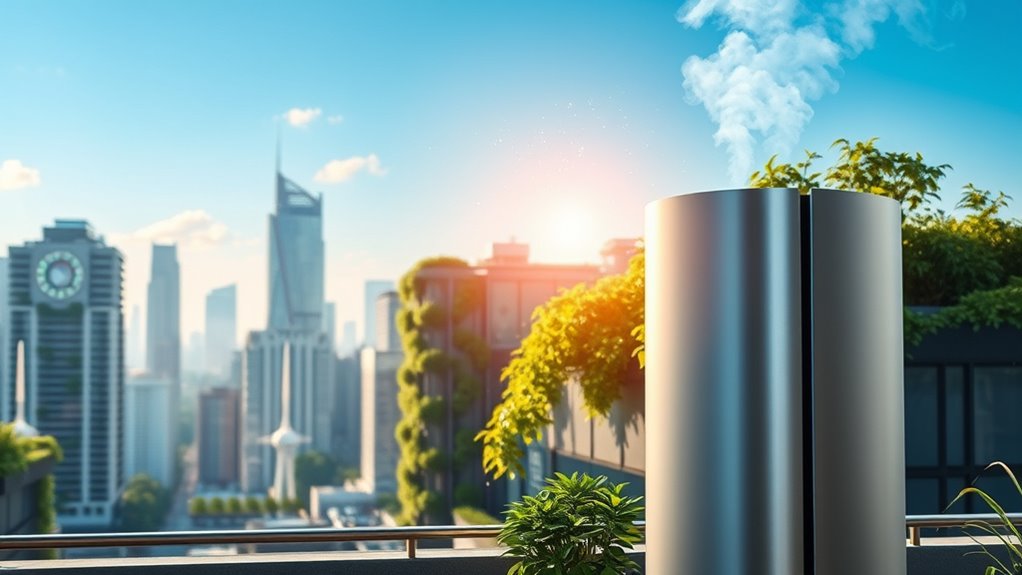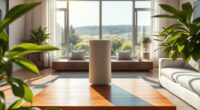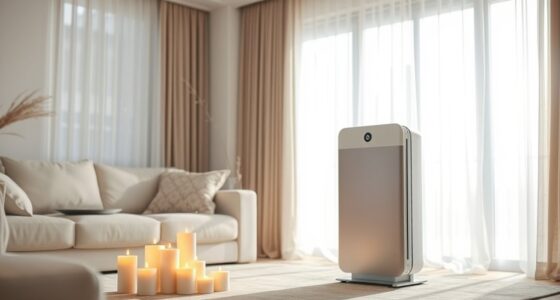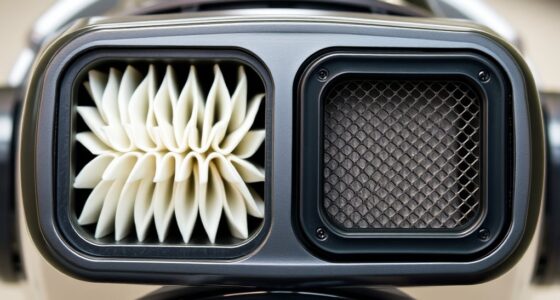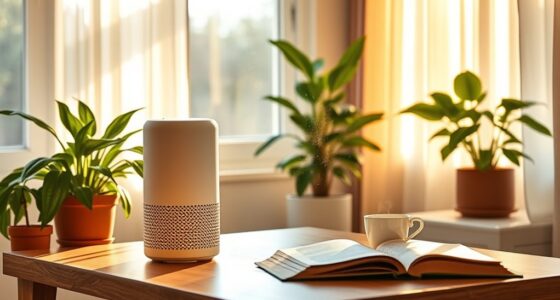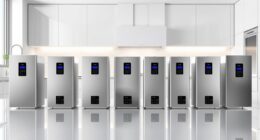The future of air purification technology is shaping up to be remarkable. You’ll see smarter systems that adapt to air quality in real time, along with advanced multi-layered filtration processes. Innovations like active sanitization and AI integration are set to enhance efficiency and reduce allergens in your home. As more people focus on health and indoor air quality, expect to learn about exciting trends and innovations that will redefine your living spaces.
Key Takeaways
- The air purifier market is projected to grow to US$ 31.85 billion by 2033, driven by urbanization and rising health awareness.
- Smart air purifiers with real-time monitoring and adaptive filtration are increasingly popular, enhancing user experiences and air quality management.
- AI technologies will play a crucial role in predicting air quality issues and optimizing purification processes through machine learning models.
- Innovations in filtration, including nanotechnology and photocatalytic oxidation, are advancing the efficiency and effectiveness of air purification solutions.
- The demand for portable, multifunctional air purifiers and eco-friendly designs is growing, reflecting consumer preferences for convenience and sustainability.
Advanced Fan Systems for Maximum Airflow and Efficiency
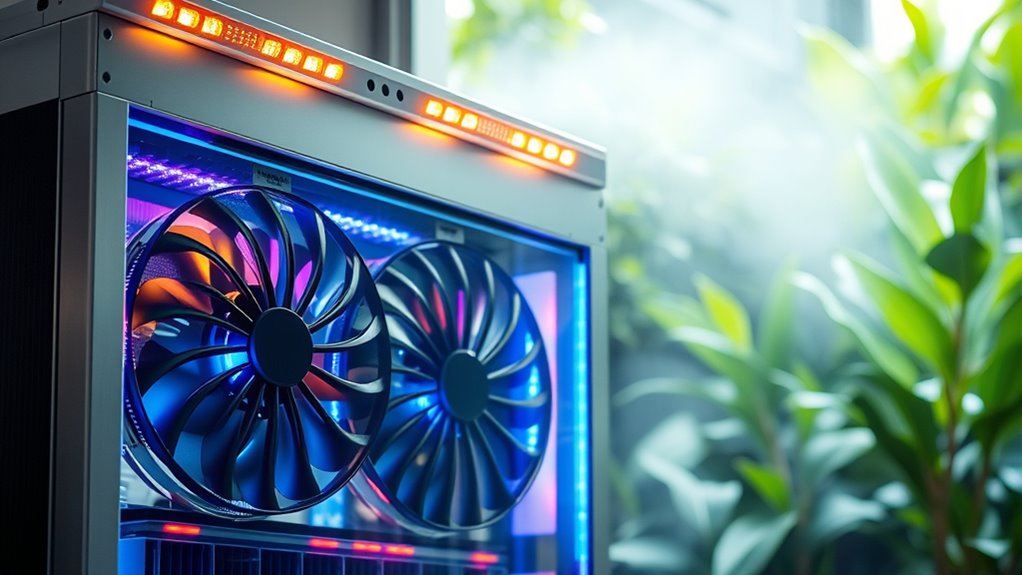
As air quality becomes a growing concern in various environments, advanced fan systems in air purifiers are stepping up to deliver maximum airflow and efficiency.
These energy-efficient technologies adjust performance based on real-time air quality, ensuring peak air purification without wasting energy. Many models utilize smart capabilities to allow for remote operation and adjustments for optimum performance. Additionally, regular maintenance tasks such as filter cleaning and replacement are crucial for maintaining efficiency and performance over time. Regularly checking and cleaning filters can significantly enhance the purifier’s efficiency. Furthermore, maintaining an organized space can contribute to overall well-being, as clutter-free environments promote mental clarity.
With smart sensors, these systems automatically respond to fluctuations in indoor air quality, so you don’t have to worry about manual adjustments.
Modern air purifiers feature multiple fan speeds and modes, enhancing airflow capacity for different room sizes and pollutant levels. Plus, with innovations like Decibel Cancellation™ Technology, you can enjoy quiet operation, making them perfect for spaces like schools and hospitals.
The future looks bright, emphasizing even quieter and more powerful airflow solutions. Additionally, many units come equipped with HEPA filters that capture up to 99.97% of airborne particles, further enhancing air quality. Properly maintained HEPA filters are essential for achieving optimal air quality in indoor environments.
Filtration Systems With Multi-Layered Protection
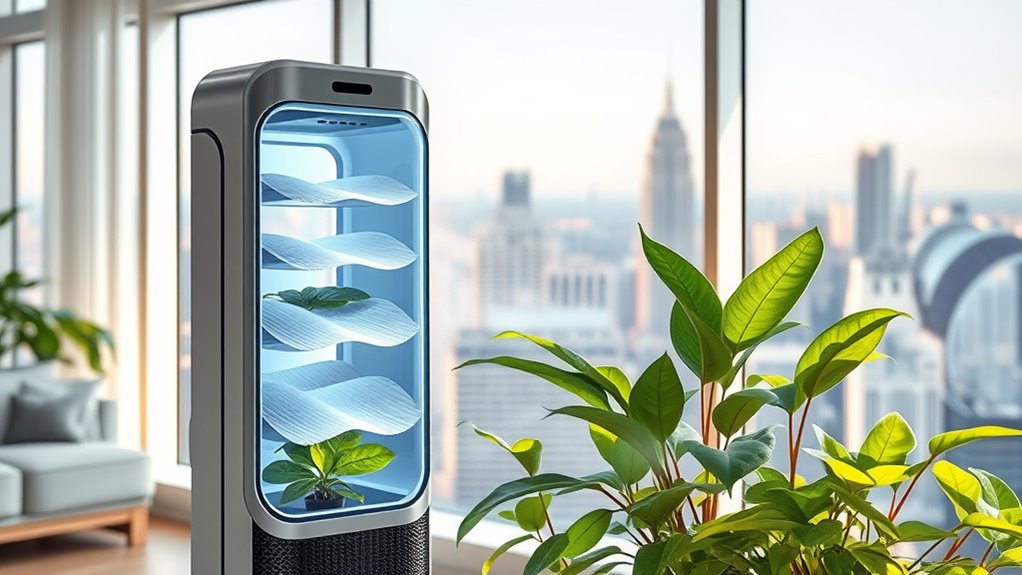
When it comes to ensuring clean air in your home or workplace, filtration systems with multi-layered protection are leading the charge. These advanced air purification systems combine HEPA filters, antimicrobial layers, and activated carbon to capture 99.97% of harmful particles while neutralizing odors and gases. Innovations like nanofibers enhance filtration beyond traditional standards, while filterless technologies, such as the NCCO system, decompose pollutants without creating waste. Plus, continuous improvements focus on energy efficiency, using longer-lasting materials to reduce environmental impact. Additionally, the integration of advanced technology in air purification systems mirrors trends seen in the best heat pumps, ensuring optimal performance and reliability. Studies have shown that incorporating energy monitoring features can further enhance the efficiency of air purification systems, allowing users to track and reduce their energy consumption. Notably, the efficiency of air purification systems can be enhanced by incorporating renewable energy solutions, such as solar energy, to power these devices sustainably. Furthermore, regular use of air purifiers can lead to improved respiratory health, providing relief for individuals suffering from allergies and asthma. Emphasizing energy-efficient technology in these systems can significantly contribute to sustainable living practices and reduce overall environmental impact.
| Layer Type | Function |
|---|---|
| HEPA Filters | Captures harmful particles |
| Activated Carbon | Neutralizes odors and VOCs |
| Antimicrobial Layer | Prevents microbial growth |
| Nanofibers | Enhances filtration capabilities |
Custom Air Purification for Different Spaces in a Post-COVID World
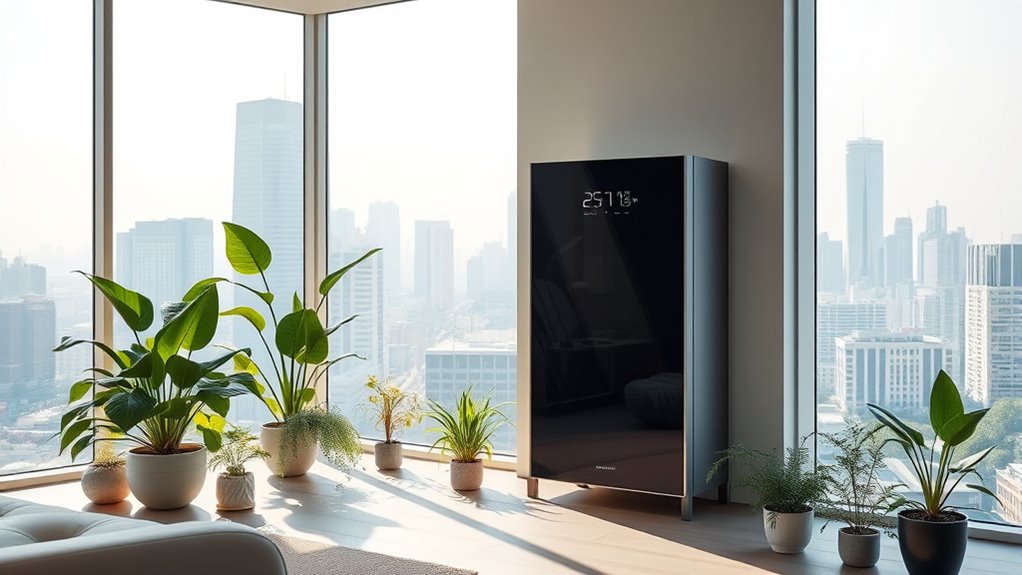
In a post-COVID world, tailored air purification solutions are essential for environments like schools and hospitals where air quality standards are critical. You’ll find that these custom systems not only enhance safety but also adapt to real-time conditions, ensuring ideal filtration. Regular filter replacement guidelines are crucial to maintain optimal performance and effectiveness in these tailored systems. Incorporating HEPA filters into these custom systems can significantly improve the removal of airborne particles, further enhancing overall air quality. Additionally, many of these systems utilize smart WiFi capabilities to monitor air quality in real-time, allowing for proactive adjustments and maintenance. Implementing these systems can also help reduce the stress on family caregivers by creating a healthier environment for those they support. Moreover, enhanced air filtration can improve compliance with health regulations, further ensuring the safety of vulnerable populations.
Tailored Solutions for Schools
Tailored air purification solutions are essential for schools maneuvering the complexities of a post-COVID world. Here’s what to take into account:
- High-performance air purifiers with advanced filtration technologies like HEPA and UV-C light can effectively reduce airborne pathogens. Additionally, portable AC units can enhance air circulation, further improving the overall air quality in classrooms. Moreover, utilizing energy efficiency ratings can help schools choose the best systems that minimize energy consumption while maximizing air purification. Incorporating energy-efficient appliances can contribute to long-term savings on utility bills. Furthermore, heat pumps can be integrated into the building’s HVAC systems to further improve indoor air quality.
- Real-time air quality monitoring through smart sensors guarantees ideal filtration levels during peak usage times.
- Customized air purification solutions often include whisper-quiet fan systems, maintaining a conducive learning environment without noise disruption.
- With IoT integration, you can remotely monitor indoor air quality, gaining insights into pollutant levels, humidity, and temperature.
- Additionally, integrating energy-efficient systems can enhance overall sustainability and reduce operational costs, aligning with broader environmental goals.
Hospital Air Quality Standards
As the world adapts to the realities of a post-COVID environment, hospitals must prioritize stringent air quality standards to protect patients and staff alike.
Advanced air purification technologies, such as HEPA filters and UV-C disinfection, are now essential for removing airborne contaminants, ensuring up to 99.997% of harmful particles are eliminated.
Organizations like the WHO recommend maintaining high indoor air quality, particularly in waiting rooms and treatment areas, to minimize transmission risks.
Hospitals are adopting smart air purification systems featuring real-time monitoring that adjusts filtration levels based on detected pollutants, enhancing safety.
The demand for custom air purification solutions has surged, focusing on both air and surface hygiene to improve health outcomes and create safer healthcare environments. Additionally, fresh orange juice can last only 2-3 days when refrigerated, highlighting the importance of maintaining optimal conditions not just for air quality but for all health-related factors.
Integration With Matter: Smart Homes and Iot Air Purification
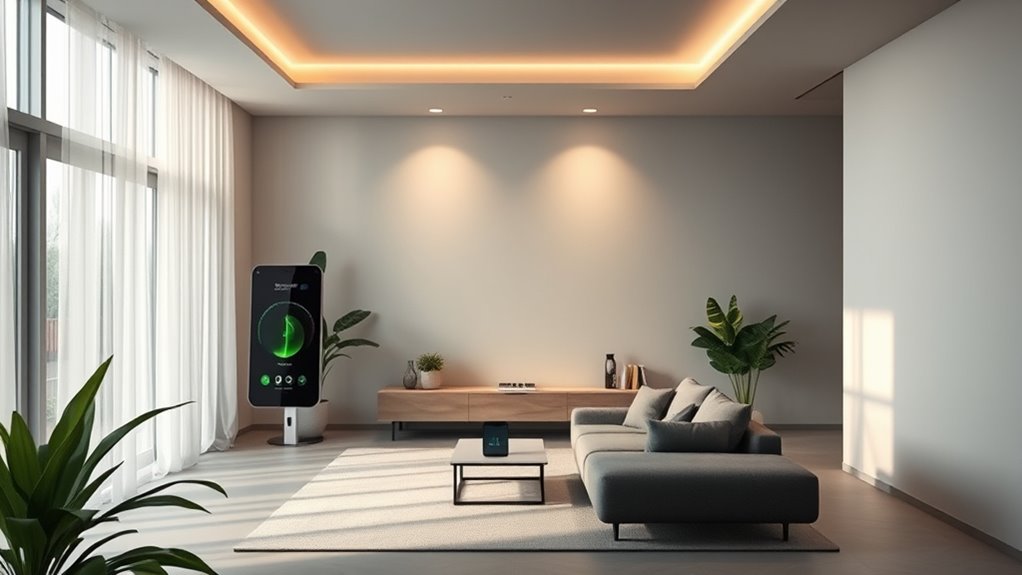
While many households are embracing smart technology, the integration of air purifiers with the Matter standard is transforming how you manage indoor air quality.
This seamless connectivity enhances user convenience and interoperability across devices. Here are some key benefits you can expect:
- Automatic Adjustments: Smart air purifiers equipped with advanced sensors can adapt filtration levels based on real-time air quality data.
- Remote Monitoring: Over 800 models offer continuous air quality analytics accessible via smartphones.
- Voice Activation: In 2023, over 15 million households adopted voice-activated air purifier systems, showcasing the trend of IoT technologies.
- Cloud Diagnostics: This feature facilitates effective remote monitoring and maintenance of air purification systems.
These innovations make managing your home’s air quality easier than ever.
Cost-Effective and Environmentally Friendly Solutions
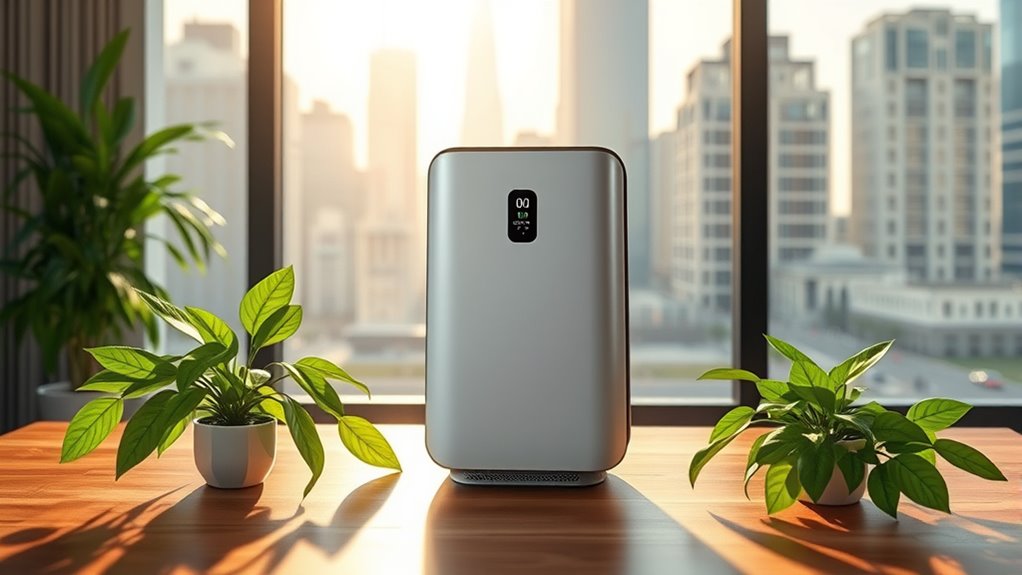
Smart home technology not only enhances convenience but also opens doors to cost-effective and environmentally friendly air purification solutions.
As consumer awareness about health impacts grows, you’ll find a rising demand for affordable purifiers that maintain high performance. Manufacturers now emphasize eco-friendly designs, integrating energy-efficient fan systems and sustainable materials to reduce waste.
Advanced filtration technologies, like reusable filters made from corn protein, promote sustainability while minimizing landfill contributions. Plus, energy-efficient models often utilize variable speed technology and smart scheduling, optimizing performance and lowering your operational costs.
With these innovations, you can enjoy cleaner air without compromising the environment or your budget, making smart air purification choices that align with your values.
The Role of AI in Proactive Air Quality Management
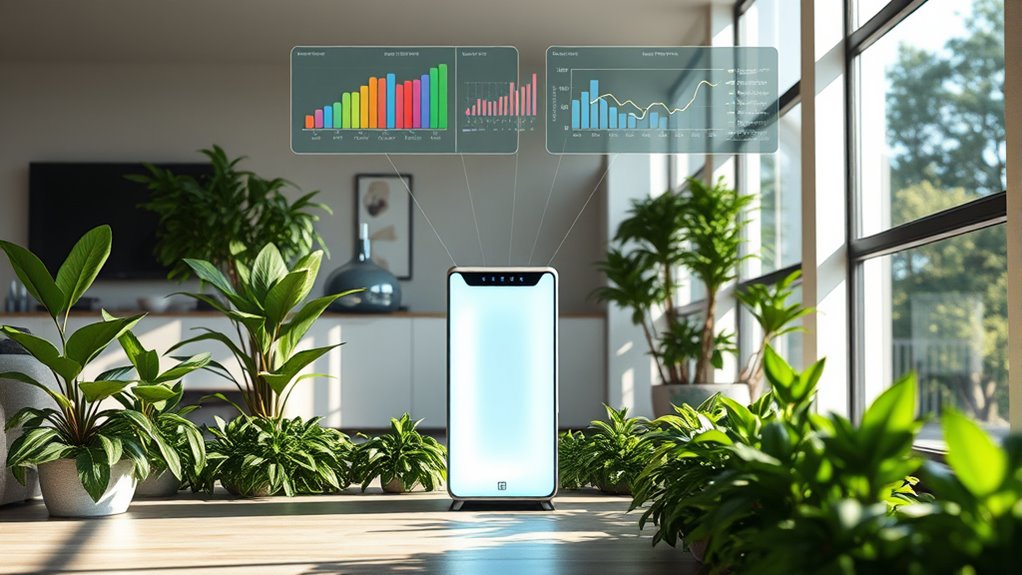
Artificial intelligence is transforming air quality management by enabling systems to respond dynamically to changing environmental conditions.
With AI technologies, you can enjoy improved indoor wellness through proactive adjustments based on real-time air quality data.
Here are some key benefits:
- Predictive Analysis: Machine learning models forecast pollution spikes and allergen sources, allowing timely interventions.
- Geospatial Mapping: AI tools identify pollution hotspots, helping communities target areas for improvement.
- Personalization: AI-driven air purifiers adapt to individual user preferences and health conditions, optimizing air quality.
- Continuous Monitoring: Advanced AI algorithms guarantee ongoing analysis of air quality data, enhancing responsiveness in purification systems.
Innovations in Active Sanitisation Technologies

As the demand for healthier indoor environments grows, innovations in active sanitisation technologies are stepping up to meet the challenge.
Indoor air purifiers now feature advanced technologies like Purox™ Gel and UV-C light, which neutralise harmful substances, including bacteria and viruses, on contact.
Devices such as the EnviroGuard PRO X™ combine active sanitisation and traditional filtration, enhancing air quality and surface hygiene.
These innovations focus on real-time air purification, effectively deactivating airborne pathogens and addressing consumer demand for safer living spaces, particularly post-COVID-19.
Research shows that air purifiers with active sanitisation methods greatly reduce airborne pathogens, contributing to improved hygiene and peace of mind in both homes and workplaces.
The Importance of Aesthetic and Functional Design
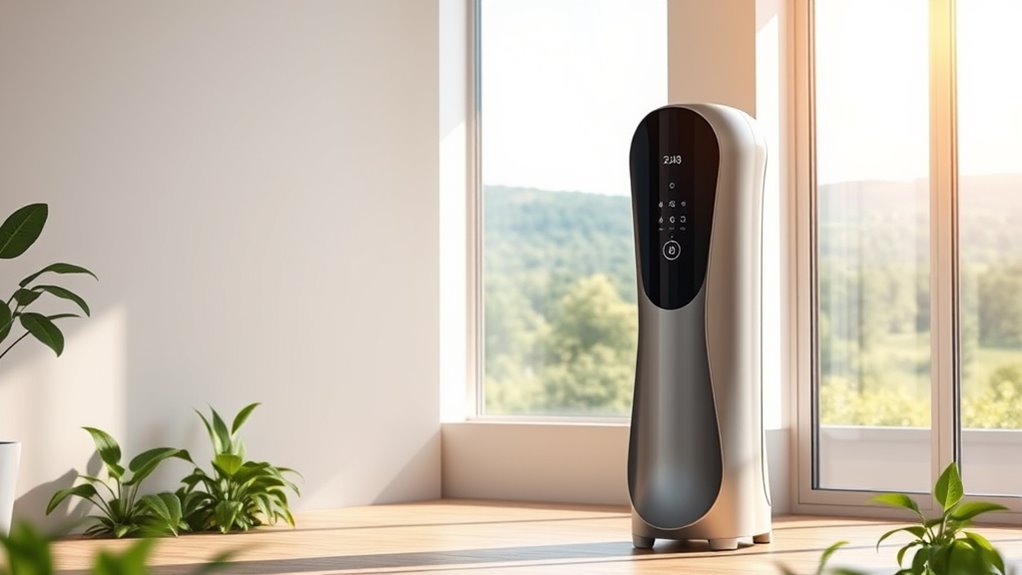
As you look for air purifiers, sleek designs make it easier to blend these devices into your home or office decor.
Plus, with modern models offering multiple functions like humidifying and cooling, you get more value for your investment.
Emphasizing both aesthetics and utility, today’s air purifiers cater to your desire for style without compromising on performance.
Sleek Design Integration
When it comes to air purifiers, sleek design integration has become essential for modern living spaces. You want a device that not only enhances air quality but also complements your interior.
Here are some key features to take into account:
- Compact Form: Modern purifiers fit seamlessly into any indoor environment.
- Aesthetic Appeal: Manufacturers focus on designs that are visually striking yet functional.
- Advanced Fan Systems: These guarantee low noise while effectively circulating air.
- Smart Systems: Many purifiers now offer connectivity for user-friendly control.
With accessible air purification technology at various price points, you can choose sleek designs without compromising on performance.
Embracing these innovations lets you enjoy cleaner air while reflecting your personal style.
Multi-Functional Devices
Sleek designs aren’t just about looks; they play an essential role in the rise of multi-functional air purifiers that enhance your living and working spaces.
These modern devices often combine air purification with additional functions, like humidifiers or cooling fans, providing greater utility. With advanced air purification technology, you can enjoy improved air quality while benefiting from user convenience offered by smart technology.
Imagine controlling your air purifier remotely, with real-time monitoring accessible via your smartphone.
Plus, many of these innovative models use eco-friendly materials, reflecting a commitment to sustainability.
Market Growth Projections and Consumer Adoption Trends
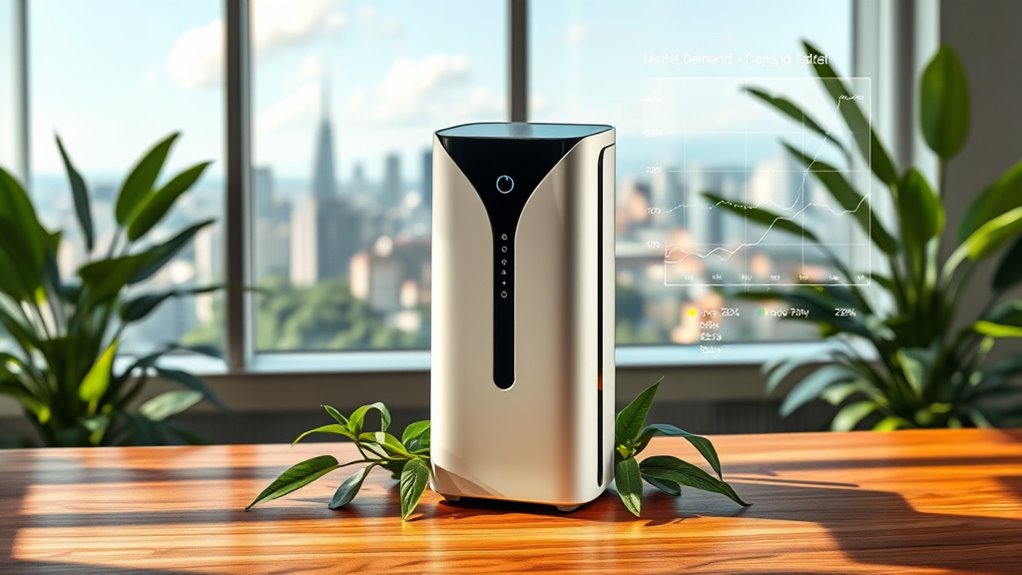
The air purifier market is set for significant growth, with projections indicating it could reach US$ 31.85 billion by 2033.
This surge is driven by several factors:
- Urbanization is increasing the demand for effective air purification solutions.
- Advanced air purification solutions are becoming essential, especially in densely populated areas.
- Consumer adoption trends show heightened awareness of health impacts due to air quality issues.
- Smart home systems are integrating air purifiers, making them more accessible and appealing.
With a projected CAGR of 6.80% from 2025 to 2033, air purifiers featuring advanced filtration technologies are gaining traction.
As more consumers invest in these devices, the future of air quality management looks promising.
Health Benefits and Impact on Indoor Environments
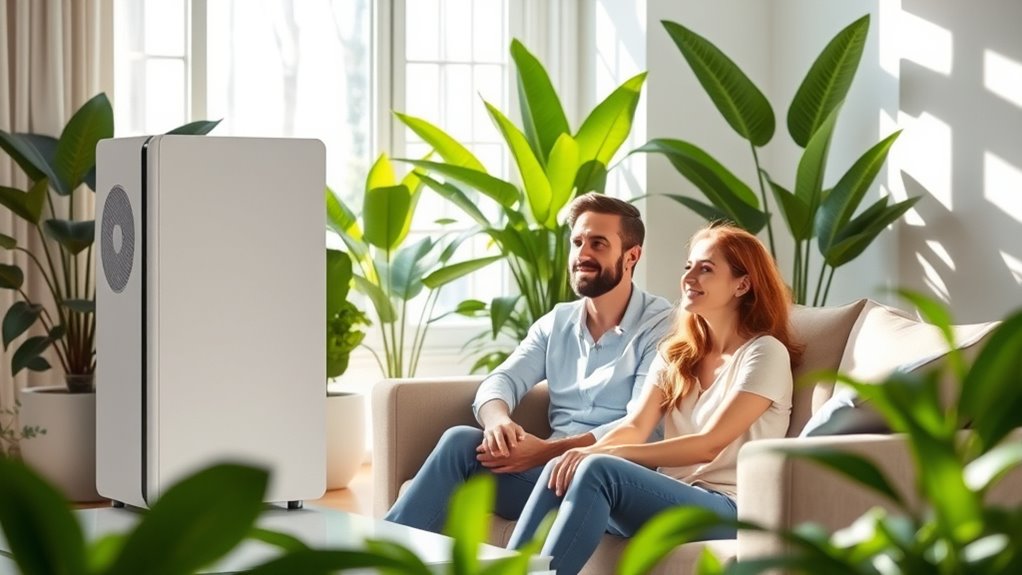
As urban pollution continues to rise, many people are turning to air purifiers to enhance their indoor environments and safeguard their health.
By investing in air purification solutions with advanced filtration technologies like HEPA and activated carbon, you can greatly reduce allergens and harmful pollutants, leading to better respiratory health. Cleaner indoor air not only alleviates asthma and allergy symptoms but also correlates with fewer healthcare visits for respiratory issues.
Furthermore, improved air quality boosts productivity and cognitive function, helping you concentrate better and feel less fatigued.
With smart technology integrated into these devices, managing air quality becomes effortless. Prioritizing cleaner air is essential for combating the effects of urban pollution and promoting overall well-being in your home or workplace.
Frequently Asked Questions
What Is the Future of Air Purifiers?
The future of air purifiers looks promising as you’ll see advancements in technology and design.
You can expect more efficient multi-layered filtration systems that tackle specific pollutants effectively. Smart features like real-time monitoring and AI-driven adjustments will enhance usability.
Plus, emerging technologies such as filterless systems will revolutionize how air purification works.
With rising health awareness, you’ll find a growing demand for eco-friendly and energy-efficient options that suit your lifestyle.
Which Technology Is Best for an Air Purifier?
Imagine breathing in fresh, clean air, free from allergens and pollutants.
For your air purifier, HEPA filters are a must—they capture 99.97% of harmful particles.
But don’t overlook activated carbon filters; they tackle odors and VOCs effectively.
If you want cutting-edge tech, consider smart purifiers with AI that adjust filtration based on air quality.
Alternatively, explore filterless systems like CAP technology for a waste-free solution.
Your air quality deserves the best!
What Is Air Purifying Technology?
Air purifying technology uses advanced filtration systems to clean indoor air.
You’ll find devices equipped with HEPA filters and activated carbon that capture harmful particles and allergens.
Many modern air purifiers monitor air quality in real-time, adjusting their filtration levels automatically.
Some even use active sanitization methods to neutralize bacteria and viruses.
This technology helps you breathe cleaner air, improving your overall health and comfort in your living spaces.
What Is the Market Forecast for Air Purifiers?
The market forecast for air purifiers looks promising. By 2033, it’s projected to reach USD 31.85 billion, growing at a CAGR of about 6.80% from 2025 to 2033.
In 2023 alone, demand surged with 2 million advanced models shipped and 5 million installations in Asia. North America also reported strong sales, with 3 million units sold.
This growth reflects your increasing awareness of air quality and the need for better purification solutions.
Conclusion
As air purification technology evolves, you’re bound to benefit from bold breakthroughs and brilliant designs. From advanced filtration to smart integrations, these innovations not only enhance your home’s health but also harmonize with your lifestyle. By embracing eco-friendly options, you’ll guarantee cleaner, clearer air while contributing to a sustainable future. Keep an eye on the exciting evolution of air purification, and stay confident that a wave of new air is just around the corner!
